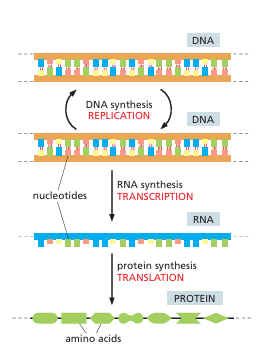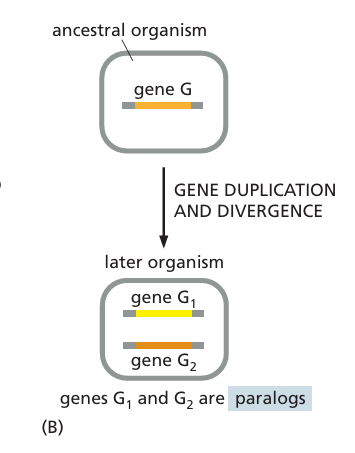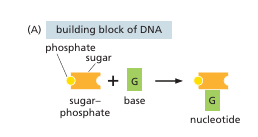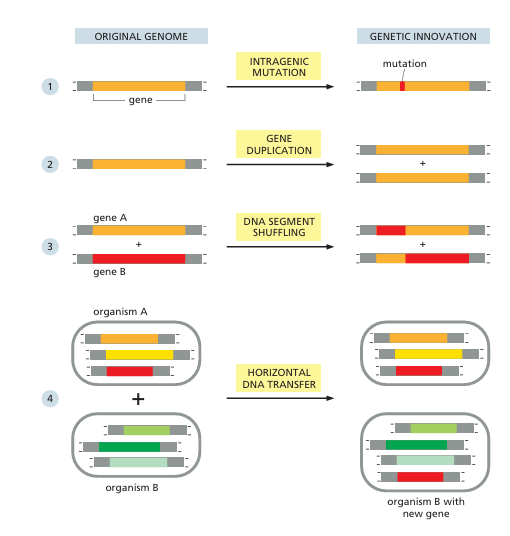CH 1: Cells, Genomes, and the Diversity of Life Vocabulary
1/34
Earn XP
Description and Tags
Flashcards covering key vocabulary and definitions from Chapter 1: Cells, Genomes, and the Diversity of Life from the textbook Molecular Biology of the Cell, 7th Edition.
Name | Mastery | Learn | Test | Matching | Spaced |
|---|
No study sessions yet.
35 Terms
Cells
Small, membrane-enclosed units filled with a concentrated aqueous solution of chemicals, able to create copies of themselves by growing and then dividing in two.
Cell biology
The study of the structure, function, and behavior of cells.
Genome
The totality of the hereditary information embodied in the linear sequence of nucleotides in the DNA.
Transcription
The process in which segments of the DNA sequence are used as templates for the synthesis of shorter molecules of the closely related polymer ribonucleic acid, or RNA.
This process is essential for gene expression.

Translation
The process in which RNA molecules direct the synthesis of polymers of a radically different chemical class—the proteins.

Catalyst
Any molecule that speeds up a specific chemical reaction without itself being changed.

Gene
The segment of DNA sequence corresponding either to a single protein (but sometimes to a set of closely related, alternative protein variants) or to a single catalytic, regulatory, or structural RNA molecule.
Eukaryotes
Organisms characterized by cells that contain a nucleus and other membrane-bound organelles. The nucleus houses the cell's DNA, allowing for compartmentalization of cellular processes. Eukaryotes include a wide range of organisms, such as animals, plants, fungi, and protists, and are generally more complex than prokaryotes.
Prokaryotes
Prokaryotes (bacteria and archaea) are domains of life lacking a nucleus and membrane-bound organelles. They are simpler than eukaryotes, with diverse metabolic capabilities and a single circular chromosome in the cytoplasm.

Phototrophic
They harvest the energy of sunlight
Lithotrophic
That capture their energy from energy-rich systems of inorganic chemicals in the environment (chemical systems that are far from chemical equilibrium).
Mutation
A change in the nucleotide sequence.
Orthologs
Genes in two separate species that derive from the same ancestral gene in the last common ancestor of those two species

Paralogs
Related genes that have resulted from a gene duplication event within a single genome—and are likely to have diverged in their function

Plasma membrane
A selective barrier that enables the cell to concentrate nutrients gathered from its environment and retain the products it synthesizes for its own use, while excreting its waste products.
Nucleus
Internal compartment where eukaryotic cells keep almost all their DNA.
Cytoskeleton
Give the cell mechanical strength and performs various other functions
Endocytosis
Process where portions of the plasma membrane pinch in to form intracellular vesicles that carry material captured from the external medium into the cell
Exocytosis
Reverse process where vesicles from inside the cell fuse with the plasma membrane and release their contents to the exterior
Mitochondria
Organelles that take up oxygen and harness energy from the oxidation of food molecules, such as sugars and fats, to produce most of the ATP (adenosine triphosphate) that powers the cell’s activities.
Chloroplasts
Perform photosynthesis in plant cells and algae, using the energy of sunlight to synthesize carbohydrates from atmospheric CO2 and water, delivering these energy-rich products to the host cell as food.
Cell-division cycle
Process is the critical chain of events by which the nucleus and all the other components of a cell are duplicated and parceled out to create two daughter cells from one.
Meiosis
The process through which an organism’s reproductive cells are formed
Nucleotides
Building blocks of DNA and RNA:
DNA: Adenine (A), Guanine (G), Cytosine (C), and Thymine (T).
RNA: Adenine (A), Guanine (G), Cytosine (C), and Uracil (U).
Consisting of a nitrogenous base, a sugar, and a phosphate group.essential components of nucleic acids.

RNA Molecule
formed from Ribose instead of deoxyribose like DNA, one of the 4 bases is different: Uracil (U) replaces Thymine (T). It plays a crucial role in protein synthesis and gene expression.
Types of RNA
mRNA: messenger RNA guides protein synthesis
tRNA: transfer RNA carries amino acids
rRNA: ribosomal RNA forms ribosomes
Amino Acids
The building blocks of proteins. Each amino acid contains a central carbon atom linked to an amino group (-NH2), a carboxyl group (-COOH), a hydrogen atom (-H), and a variable side chain (-R).
Protein Functions in the Cell
Proteins perform a wide array of functions in the cell, including:
-Catalyzing biochemical reactions (enzymes)
-Transporting molecules across membranes
-Providing structural support (cytoskeleton)
-Generating movement (motor proteins)
-Regulating gene expression (transcription factors)
-Signaling and communication
ATP in Cells
ATP (adenosine triphosphate) is the primary energy currency in cells, essential for powering metabolic reactions, molecular synthesis, transport processes, and maintaining cellular functions.
Plasma Membrane Function & Physiochemical Properties
The plasma membrane maintains an optimal internal environment through selective permeability, employing protein channels and pumps to regulate the passage of specific molecules and ions. Its amphipathic lipid bilayer provides a hydrophobic barrier, while embedded proteins facilitate transport and signaling, enabling the cell to concentrate nutrients, retain synthesized products, and remove waste effectively.
Brownian Motion
The random movement of particles in a fluid (liquid or gas) due to their collision with other atoms or molecules.
Diffusion
The net movement of molecules or atoms from a region of high concentration to a region of low concentration as a result of random motion. This process is driven by a gradient in concentration.
Archaea
One of the three domains of life, known for inhabiting extreme environments. They are prokaryotic, lacking a nucleus, and have unique cell membrane and wall compositions.
Types of Mutation
Encompass:
- Point mutations (single base substitutions)
- Insertions (addition of bases)
- Deletions (removal of bases)
- Frameshift mutations (reading frame shift)
New Gene Generation
New genes can arise through various mechanisms:
- Intragenic mutation: Modifying an existing gene's sequence.
- Gene duplication: Creating a copy of an existing gene.
- DNA segment shuffling: Recombining segments from different genes.
- Horizontal transfer: Acquiring genes from another cell.
